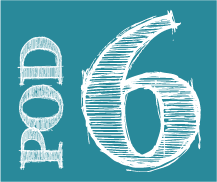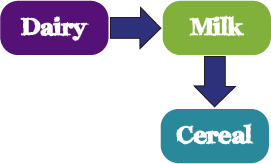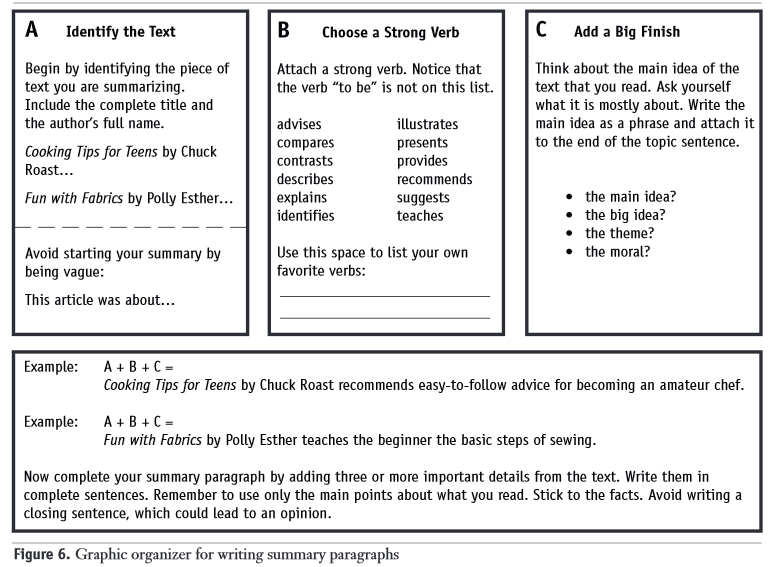Organizing Research / Understanding Nutrition Labels and Bar Charts
 With the vast amount of information sources available, helping students to organize their research is not as easy as helping them make notecards or binders of information. This pod includes activities to teach students how to take good notes and how to save resources they find on the Internet. The pod also includes lessons focused on visual and numerical literacy, helping students to read charts and labels accurately. Download Pod.
With the vast amount of information sources available, helping students to organize their research is not as easy as helping them make notecards or binders of information. This pod includes activities to teach students how to take good notes and how to save resources they find on the Internet. The pod also includes lessons focused on visual and numerical literacy, helping students to read charts and labels accurately. Download Pod.
Topics in this Pod
- How to take good notes
- How to save resources
- How to read a nutrition label
- How to interpret a bar chart
Essential Questions
- How can I keep track of my research?
- How can I take notes so I can be more efficient?
- What is the best way for me to save websites and other information so that I can find them again?
- How can I read, understand, and use the information in a nutrition label?
- How can I interpret the information displayed in a bar chart?
Vocabulary
- Mind-mapping: a way to diagram notes or ideas visually
- Bar chart: a way of graphically comparing variables of different numerical values with vertical or horizontal wide lines
- Summarization: extracting the most important points of an oral or textual piece.
- Plagiarism: copying another person’s work without permission or crediting the author/\
- Nutrition label: A label that shows an analysis of the nutritional content of a food or beverage.
- Calorie: A measure indicating the amount of energy provided by a food.
- Carbohydrate: A measure of the amount of starch or sugar in a food.
- Bar chart: A chart that uses vertical or horizontal bars to portray numerical information.
- Fitbit: A fitness tracking device that keeps track of several different measures, such as the number of steps you have taken, the number of floors of stairs you have climbed, and the number of calories you have burned.
Activities
KWL Whole Group Activity. In this activity, students will begin the process of identifying their preferred note-taking strategy by recalling what has and hasn’t worked for them in the past. By sharing this information with their peers, the group will benefit from each individual’s experiences. See More.
How to Take Notes. In this activity, students will learn three different options for taking notes: mind-mapping, the VIP strategy, and making lists. This activity will help students to realize there are many ways to take notes, they just need to find the best option for the way they learn. See More.
Online Organization Tools. In this activity you will introduce a digital note-taking activity to your students. See More.
Reviewing Note-taking. In this activity, students practice note-taking strategies both in small groups and individually. They will use websites to summarize material, avoiding plagiarism. See More.
Post-assessment: KWL Whole Group Activity. Students will review what they have learned about note-taking and will refer back to what they wanted to know at the beginning of the session. See More.
Reading a Nutrition Label. Students will practice reading a nutrition label, demonstrating the need for numerical literacy when finding information on and offline. See More.
Interpreting a bar chart. Students will learn what a bar chart is, will view a sample bar chart and answer questions about it, and will practice charting information on their own selected topic. See More.
Goals
At the end of the pod, students will be able to:
- Organize information on a topic in a mode that they can use to create their final project.
- Understand the information shown in a nutrition label and understand why it’s important.
- Accurately interpret the information depicted in a bar chart.
AASL Standards
1.1.6 Read, view, and listen for information presented in any format (e.g., textual, visual, media, digital) in order to make inferences and gather meaning.
1.1.7 Make sense of information gathered from diverse sources by identifying misconceptions, main and supporting ideas, conflicting information, and point of view or bias.
2.1.2 Organize knowledge so that it is useful.
2.1.3 Use strategies to draw conclusions from information and apply knowledge to curricular areas, real-world situations, and further investigations.
2.1.4 Use technology and other information tools to analyze and organize information.
3.1.4 Use technology and other information tools to organize and display knowledge and understanding in ways that others can view, use, and assess.
4.1.6 Organize personal knowledge in a way that can be called upon easily.
KWL Whole Group Activity.
- Ask students to share what note-taking strategies they have used in the past. Throughout this activity, write answers on the chart paper to refer back to at the end of the session.
- Follow up by asking how they have organized their research for other classes.
- Ask them what worked for them and what did not.
- Then, ask students what they feel like they still need or want to know, e.g. what problems have they had with organizing and/or note-taking.
- If it doesn’t come up in the discussion previously, ask students why it’s important to organize research and take notes.
How to take notes.
(Inspiration for aspects of this activity came from Osborne, M.A. (2009). Taking notes: Synthesizing information from a source. Available: http://www.slideshare.net/maryaliceosborne/learning-to-take-notes
Mind-mapping
- Introduce the concept of mind-mapping, or a way to diagram notes and ideas visually. Show them what a mind map of a grocery list might look like.

- In a whole group, create a mind map for our whole group project (Alzheimers) using the National Library of Medicine page (http://www.nlm.nih.gov/medlineplus/alzheimersdisease.html).
- Ask students why this is a good/bad strategy.
- Answers might include: good for visual learners; hard to do with a lot of information; nice to summarize all of your ideas.
Tables: VIPs and Sum It Up*
- Introduce the VIP method of note-taking.

Figure 6 sourced from: Goodman, A. (2005). The middle school high five: Strategies can triumph. Voices from the Middle, 13(2), p. 17. Available: http://www.ncte.org/library/NCTEFiles/Resources/Journals/VM/0132-dec05/VM0132Middle.pdf
- Have students identify six main ideas from the piece of text they are summarizing. Limit them to six options so that they have to pick the most important. They can use a highlighter tool in an online organizing program or identify sentences by writing them down (with quotes) if using analog note-taking.
- Have students reduce the main ideas to three once they’re done.
- Then have students summarize the text by using the graphic organizer below. Have them identify the text, choose a strong verb, and add the finish using their main ideas.
- Take the same website (http://www.nlm.nih.gov/medlineplus/alzheimersdisease.html) and use the VIP strategy in a whole group.
- Ask students why this is a good/bad strategy.
Making Lists
- Introduce the list method of note-taking. Ask students to think about their favorite meal.
- Give the example of spaghetti, green beans, salad, and garlic bread.
- Have students give examples of the ingredients you might need to make the meal.
- Ask if you’d want to put all of them together of if you’d want to separate into the different dishes.
- Demonstrate what this would look like on chart paper.
- Take the same website (http://www.nlm.nih.gov/medlineplus/alzheimersdisease.html) and use the list strategy in a whole group.
- Ask students why this is a good/bad strategy.
*Strategy sourced from Goodman, A. (2005). The middle school high five: Strategies can triumph. Voices from the Middle, 13(2), 12-19. Available: http://www.ncte.org/library/NCTEFiles/Resources/Journals/VM/0132-dec05/VM0132Middle.pdf
Online Organization Tools.
This will depend on the chosen tool, but generally with all tools we recommend you to:
- Introduce the site to students and show them how to log in.
- Explain why digital note-taking might be a good choice when using digital sources.
- You might include: easier to keep track of notes, easier to transfer notes to a digital project tool, easier to save sites for future use, and easier to annotate digital sources without printing them out.
- Help students to log in. We recommend having a class log-in and separate folders for each student, but depending on the tool, this may not be an option.
- Show them various functions of the site
- How to download the tool’s widget to their browser so that they can save sites easily;
- How to save a webpage using the widget;
- How to tag sites;
- How to create notes within the tool; and
- How them how to annotate or create a note with the site.
- After modeling the tool, have the students try saving a webpage to their folder and making at least one comment on the page.
Reviewing Note-taking.
- Form students into three groups.
- Using one website (http://www.alz.org/alzheimers_disease_what_is_alzheimers.asp), have each group try a different note-taking strategy (mind-mapping, VIPs, Lists).
- Ask each group to sum up the website in a short paragraph, no more than three sentences long.
- Have students present both their notes and their short paragraph to the group and compare the different interpretations. Check to see if the paragraph is a summary or if there is plagiarism.
- Ask students to pick their favorite strategy and try it on a website they’ve found in previous weeks.
- Help each student save their notes to a folder in the organization tool the class is using or, for the students who use mind-mapping, how to take a picture of their hand-drawn mind map and email it to themselves to save.
- Compare summarization to check for plagiarism
Post-assessment: KWL Whole Group Activity.
- Ask students what they learned.
- Try to get each student to share which is their favorite note-taking strategy (make sure to ask if there are any we didn’t cover that they would like to learn or are already familiar with).
- Follow up with students as they are doing their research to see if they’re using any of the strategies (especially the one they identified as their favorite).
Reading a Nutrition Label.
- Ask students if they know what a nutrition label is. Ask them to describe what a nutrition label is and to call out some reasons that someone might need the information on them.
- These may include: trying to lose weight, trying to control diabetes, allergic to certain ingredients, etc.
- Have students work in pairs on the Nutrition Facts worksheet.
- Go over their answers as a group, addressing any points of confusion.
Interpreting a bar chart.
- Ask if anyone knows what a bar chart is. If yes, ask them to describe what a bar chart might show and to talk about an example they have seen.
- Ask if anyone knows what a fitbit is. Show them an actual fitbit and walk them through the various displays (e.g., current time, steps, floors, distance, calories burned, and the flower visualization), explaining what each one shows.
- Have students work in pairs on the Bar Chart worksheet.
- Go over their answers as a group and address any points of confusion.
- Give each student a piece of poster paper and ask them to draw a bar chart that is related in some way to their selected research topic. They may need to do some searching in order to identify relevant factors that can be charted. Point out that the data for the chart can be completely made up. The goal of this exercise is just to get them thinking about how and why one might make a bar chart.
- Ask a few students to volunteer to share their charts with the group.
